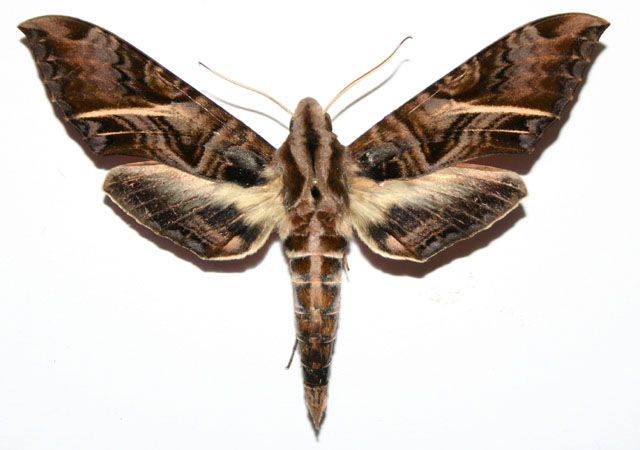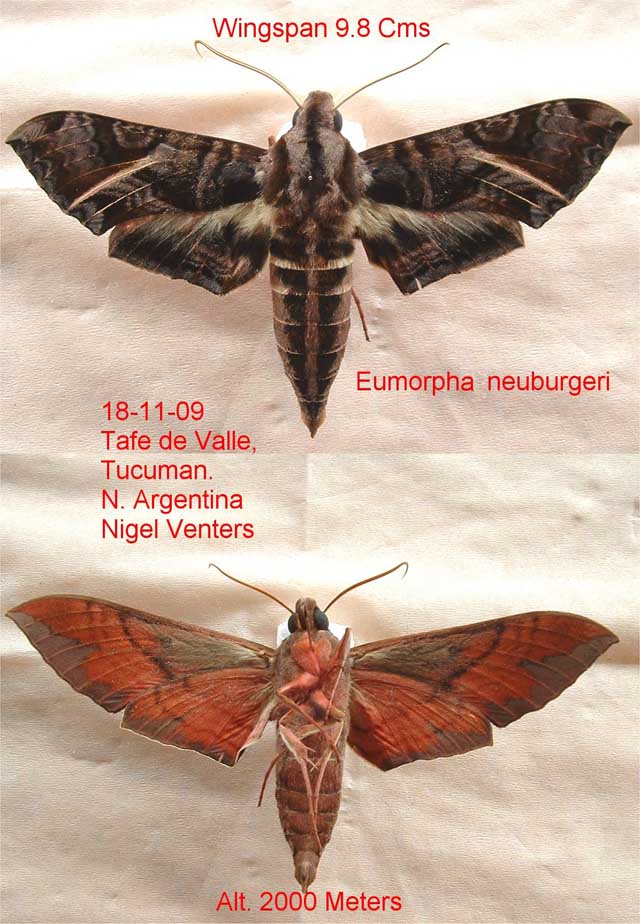Eumorpha neuburgeri
|
|
Updated as per
AN ANNOTATED CHECKLIST OF THE SPHINGIDAE OF BOLIVIA, October 2007
Updated as per More, Kitching and Cocucci's Hawkmoths of Argentina 2005, October, 2007
Updated as per personal communication with Fernando Penco, May 2008
Updated as per personal communication with Nigel venters (Tafe de Valle, Tucuman, Argentina, November 18, 2009, 2000m); November 29, 2009
Updated as per personal communication with Ezequiel Bustos (Shilap revta. lepid. 43 (172) diciembre, 2015, 615-631 eISSN 2340-4078 ISSN 0300-5267), January 4, 2016
|
Eumorpha neuburgeri
(Rothschild & Jordan, 1903)
Pholus

Eumorpha neuburgeri, Argentina: Tucuman: Cochuna,
courtesy of
Fernando Penco, late November-early December.
This site has been created by
Bill Oehlke at oehlkew@islandtelecom.com
Comments, suggestions and/or additional information are welcomed by Bill.
| TAXONOMY:
Superfamily: Sphingoidea, Dyar, 1902
Family: Sphingidae, Latreille, 1802
Subfamily: Macroglossinae, Harris, 1839
Tribe: Philampelini, Burmeister
Genus: Eumorpha, Hubner, [1807]
Species: neuburgeri, (Rothschild & Jordan, 1903) |
MIDI MUSIC
"What.A.Wonderful.World"
copyright C. Odenkirk
MIDI CITY
ON.OFF
<bgsound src="world.mid" LOOP=FOREVER>
|
DISTRIBUTION:
Eumorpha neuburgeri
(wingspan: approximately 98-106mm) flies
in
Argentina: Catamarca, Jujuy, Tucuman (1300-2000m), La Rioja, Salta, and
Bolivia: Santa Cruz: Ichilo, Buena Vista.
Fernando Penco reports this species flies in the same location
(Cochuna, Tucuman, Argentina) as do Sphinx phalerata, March;
Xylophanes schreiteri, common in
February-March and October-November; Sphinx aurigutta,
November-December;
Manduca undata December.

Eumorpha neuburgeri, 98mm, Tafe de Valle, Tucuman, Argentina,
November 18, 2009, 2000m, courtesy of Nigel Venters.
FLIGHT TIMES AND PREFERRED FOOD PLANTS:
Eumorpha
neuburgeri adults are on the wing in late November early December
in Cochuna, Tucuman Province, Argentina.
Eumorpha neuburgeri larval hosts are unknown.
ECLOSION, SCENTING AND MATING:
Pupae wiggle to surface just prior to eclosion. Females call at night, and males fly into the wind to pick up and track the pheromone plume.
EGGS, LARVAE AND PUPAE:
Larval Food Plants
Listed below are primary food plant(s) and alternate food plants. It is hoped that this
alphabetical listing followed by the common name of the foodplant will
prove useful. The list is not exhaustive. Experimenting with closely
related foodplants is worthwhile.
Return to Philampelini Index
Return to Sphingidae Index
Use your browser "Back" button to return to the previous page.

